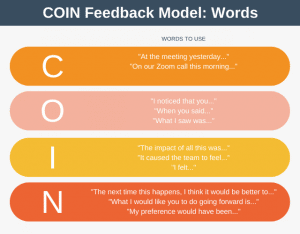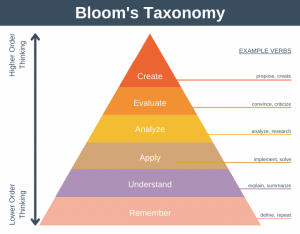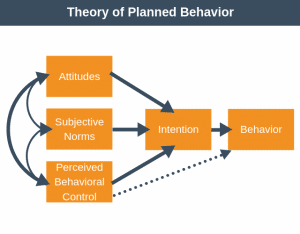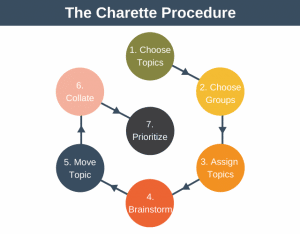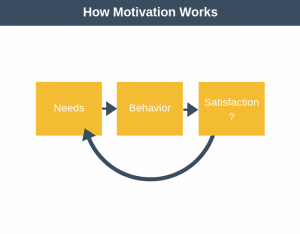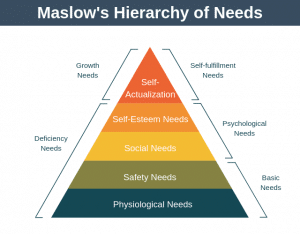The Pygmalion Effect is a psychological phenomenon whereby higher expectations lead to increased performance.
The Pygmalion Effect gets its name from ancient Greek mythology and the story of Pygmalion, who fell in love with one of his sculptures. Pygmalion is also the name of a play by George Bernard Shaw. The play explores the idea that how you treat another person impacts their life, either for better or for worse.
The Pygmalion Effect Experiment
The Pygmalion Effect was first observed in the classroom, but you can find examples of it everywhere.
The original study observing the phenomenon was conducted in a school in 1968 by social psychologist Robert Rosenthal and elementary school principal Lenore Jacobson.
The study worked by first giving students a test said to identify potential intellectual superstars. These were the students who had the highest capacity for academic growth.
The teachers were then provided with the names of these superstars. At the end of the academic year, the students were tested again, and sure enough, the superstars had progressed significantly further than their classmates over the year.
But here’s the thing – the superstars were actually chosen at random. The only difference between the superstars and their classmates was in the mind of their teacher!
Thus, the Pygmalion Effect in the classroom experiment showed that a teacher’s high expectations for a child can result in an increase in the child’s performance.
In summary, the Pygmalion Effect in the classrooms says that if a teacher believes that a child is bright, their expectations and behavior towards that child will change positively. The child will rise to this higher expectation and believe they are bright. As a result, their performance will improve, and this will then reinforce the teacher’s belief that they were right to have high expectations for the child.
Pygmalion Effect in the Workplace
It turns out that the Pygmalion Effect doesn’t just exist in schools; it exists in the workplace as well. If a manager believes that their team consists only of high-performers, they’ll outperform an equivalent team whose manager believes the opposite.
Why is this? Well, because when a team member is treated as though they are a high performer, they try to live up to that image and behave and perform how they believe a high performer would.
The opposite is also true. When a team member is treated as though they have no chance of success, they live down to this expectation and perform poorly.
It turns out that team members tend to do what they are expected to do.
The Golem Effect
Note that the Pygmalion Effect refers only to the positive case whereby positive expectations lead to increased performance.
The opposite case, whereby you place lower expectations on an individual, and this, in turn, leads to lower performance is known as the Golem Effect.
It is a negative self-fulfilling prophecy: a negative self-held belief results in poor performance. When you notice the poor performance, your negative expectations are confirmed, reinforcing your beliefs even more strongly.
The Pygmalion Effect Cycle
We can graphically represent the Pygmalion Effect as follows:
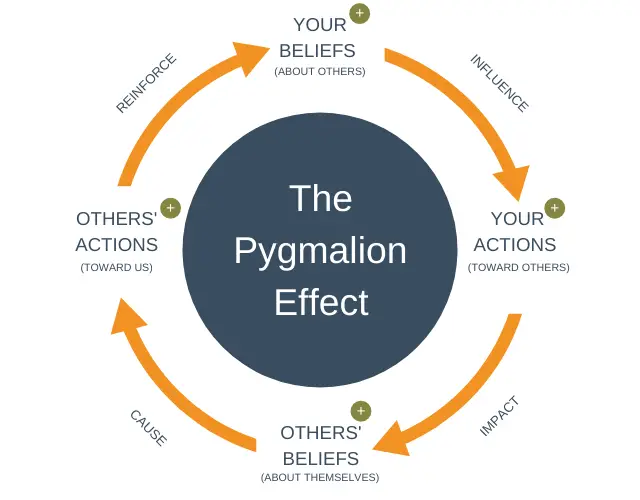
The first thing to notice in the image is that there are green circles containing a plus (+) symbol next to every step in the cycle. This is to indicate that all of the steps of the loop are positive in nature.
The cycle begins when you as a manager believe that a particular team member is capable of higher performance. This then influences your behavior and actions towards that subordinate.
This may mean that if the team member performs well, you praise them, and if they underperform, you gently support them by letting them know that you believe they are capable of much more.
The team member’s beliefs about themselves will then be impacted or nudged positively. They will start to believe just a little bit more that they are a high performer.
This new-found increased belief that they are a high performer will cause their actions and performance to improve.
Finally, this increased performance will reinforce your belief that the team member is a high-performer.
Thus begins a virtuous self-fulfilling prophecy as you go around and around the loop, with your positive beliefs about your team member being reinforced, at the same time as their positive beliefs about themselves increase and so does their performance.
Using The Model
As a manager, the Pygmalion Effect can give you a secret superpower to create a high-performing team. This is because that when you believe a team member has what it takes to become a great performer, your belief becomes a reality.
There are two facets of the Pygmalion effect you should understand:
- Raising your expectations promotes subordinate performance.
- Managers tend to allocate their time and energy to subordinates in proportion to their expectations.
To use the Pygmalion Effect, we want to treat all of our subordinates in a high-quality way that leads to superior performance.
A great subordinate-manager relationship can not only lead to superior performance, but it can also increase employee retention. A survey by Ultimate Software found that 58% of employees would turn down a 10% pay rise to stay with a great boss.
Some simple steps we can take to make use of the effect include:
1. Set challenging but not too challenging goals.
By setting goals specific to them, your subordinate will know what you expect of them. However, to benefit from the Pygmalion Effect, goals must be more than just aspirational.
For your subordinate to be motivated by a goal, they must believe that it is realistic and achievable. If you encourage subordinates to strive for unobtainable goals, they may well give up trying and deliver inferior performance.
2. Invest in your own management training.
What you believe about your own managerial ability to hire, train, and motivate your subordinates will impact your subordinates’ performance.
If you have genuine confidence in your ability, then you’ll have high expectations of your team, and your team will step up and meet these expectations.
But how do you go about increasing your own belief in your ability? One of the simplest ways is to invest in your own management training and professional development continually.
3. Give positive feedback.
Even your most productive subordinate needs occasional positive feedback on how they are performing.
Your underperformers need positive feedback too. One way to achieve this is to provide positive feedback on an area of their work, such as their effort level, before giving constructive feedback on their underperformance.
4. Train and coach your people.
You have set goals that are going to challenge your subordinate to raise their performance. Effort alone may not be enough to increase their performance to the desired level, so you need to ensure they have the right tools to enhance their performance.
There are many ways you can achieve this, the most common being through training courses, mentoring, and coaching.
5. Practice high Leader-Member Exchange leadership.
To put it in the simplest possible way, practicing high Leader-Member Exchange Theory (LMX) means exhibiting characteristics towards your subordinate such as trust, respect, acting professionally, and displaying loyalty.
Pygmalion Effect Example
Imagine this scenario. You manage a team consisting of three people, Milly, Mike, and Martin. Right now, you believe Millie is a high performer, Mike is an average performer, and Martin is an underperformer.

Having just learned about the Pygmalion Effect, you realize that your beliefs and thus behavior towards Martin have been more negative than towards the other team members.
You decide to take some simple steps to rectify this unsatisfactory situation using the Pygmalion Effect.
How would you go about using the Pygmalion Effect to improve Martin’s performance?
The problem you’ve got is that Martin isn’t a new subordinate, so you already have a lot of history with him. Because of this, the first thing you attempt to do is reset the relationship so you can start afresh, almost as though you had a clean slate.
To do this, you decide to bring Martin in for a meeting to kick things off. For our example, you choose to tackle this as follows.
First, you explain to Martin that you’re impressed with several parts of his work, such as his always positive demeanor and timekeeping. You also tell him that you’re impressed with his ability to stick things out; after all, he hasn’t left for another job yet.
Next, you explain that you know he can do better, but a big part of this is your management failings, such as not trusting him enough and giving him uninteresting tasks. To rectify this your tell Martin you’re going to attend some training.
Then you tell Martin that in the future, you’re going to assume the best from Martin. You work with Martin to set some stretch goals and agree to meet once a week for a relatively informal catch-up to help keep Martin on track.
By doing all of these things, you’ve kicked off the first loop of the Pygmalion Effect. The hope is that Martin rises to the challenge, and his performance starts to increase.
This creates the beginnings of the Pygmalion Effect’s virtuous cycle, which eventually (hopefully) leads to Martin’s superior performance.
Summary
Henry Ford has a lovely quote about how your beliefs line up with reality.
“Whether you think you can, or you think you can’t — you’re right.”
If we adjust this quote slightly, then it nicely summarises the Pygmalion Effect.
“Whether you think they can, or they can’t, you’re right.”
Rosenthal and Jacobson found that having positive expectations influenced performance positively, and they named this phenomenon the Pygmalion Effect.
